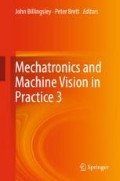Abstract
It is suggested that constructing course material using games frameworks might ameliorate problems of inattentive students. Four types of inattentive students are described and common reasons for their lack of attention in class are discussed. Each individual student possesses different levels of ‘intelligence’ or talents. Unfortunately, only a few of these are promoted, developed and assessed in most education. Fun and entertaining video games have clearly demonstrated the potential to hold the attention of students for long periods of time. This attribute can be of great value if imparted to teaching material. Some game design strategies are outlined, together with an overview of the tools that teachers will need to learn in order to develop such games.
Access this chapter
Tax calculation will be finalised at checkout
Purchases are for personal use only
References
Maersk Drilling Simulator website: URL http://www.maerskdrilling.com/en/about-us/drilling-simulator.
H. Gardner. 1983. Frames of mind: The theory of multiple intelligences, Basic Books. ISBN 0133306143.
B. Tracy. 1986. 10 keys to personal power, YouTube URL https://www.youtube.com/watch?v=IFoUOafvFNY.
B. Tracy, Accelerated learning techniques (Audio tape), Nightingale-Conant; USA, 1996 (ISBN-10: 0671536842, ISBN-13: 978-0671536848)
Kiyosaki, R.T. 2013. Why A students work for C students and B students work for the government. USA: Plata. ISBN 978-1-61268-076-7.
Moon lander and other simple simulations. URL http://www.jollies.com.
Car Mechanic Simulator: URL https://www.youtube.com/watch?v=Lr0mcRpYhSc.
Scrap Mechanic website, URL http://www.scrapmechanic.com.
Unreal Engine 4, URL www.unrealengine.com.
Unity 3D website, URL https://unity3d.com.
GameGuru, AGK (AppGameKit) & Dark Basic website, URL www.thegamecreators.com.
Amy Jo Kim, Smart gamification: Seven core concepts for creating compelling experiences. URL https://www.youtube.com/watch?v=F4YP-hGZTuA.
Robert Torres—Transforming Education with Gamification, URL https://www.youtube.com/watch?v=h_okPIMyv9c.
Sebastian Deterding, Meaningful play: Getting gamification right, Google Tech Talk, January 24, 2011: URL accessed June 30, 2015. URL https://www.youtube.com/watch?v=7ZGCPap7GkY.
K.M. Kapp. 2012. The gamification of learning and instruction: Game-based methods and strategies for training and education, USA: Pfeiffer, ISBN-13: 978-1118096345, ISBN-10: 1118096347.
K.M. Kapp, L. Blair., and R. Mesch. 2013. The gamification of learning and instruction fieldbook: Ideas into practice, USA: Pfeiffer. ISBN-13: 978-1118674437, ISBN-10: 111867443X.
B. Burke. 2014. Gamify: How gamification motivates people to do extraordinary things, Bibliomotion, ISBN-10: 1937134857, ISBN-13: 978-1937134853.
L. Sheldon. 2011. The multiplayer classroom: Designing coursework as a game, Cengage Learning PTR, 1st ed. ISBN-10: 1435458443, ISBN-13: 978-1435458444.
Acknowledgements
The authors wish to acknowledge the financial support of the General Studies Department, Arts and Science Program, Petroleum Institute, Abu Dhabi, United Arab Emirates (UAE).
Author information
Authors and Affiliations
Corresponding authors
Editor information
Editors and Affiliations
Appendix: A Game that Teaches First Year Dynamics Topics
Appendix: A Game that Teaches First Year Dynamics Topics
You are at the controls of a capsule orbiting a black hole at a radius of 800 km. The mass of the black hole is similar to that of the Earth and your time per orbit is around four minutes. Your capsule has a ‘universal propulsion drive’ that can accelerate it in any direction, but to save you from injury it is limited to 8 g.
In level one, your mission is to pursue and destroy another capsule in the same orbit. Rotational inertia is included in the model, so that directing your thrust is not simple. When you apply that thrust, the acceleration will take you in unexpected directions. When you fire a projectile, its path will be an orbital curve. Success will take you to level two.
Suddenly a missile appears 400 km away in the same orbit. Its not-so-simple guidance system accelerates it towards you at 10 g. If it can get within 1 km it will detonate and destroy you. How can you escape? It can accelerate faster than you can.
Perhaps you can ‘dodge aside’, as you might in a bullfight, letting the missile hurtle past you. Maybe you can coax the missile into greater and greater sweeps as it pursues you, but can you keep that up for long? How can you put it out of action?
Close to a black hole, ‘gravity gradient’ can become significant. Here it is only around a six-thousandth part of a g per metre, but the gradient is proportional to the inverse cube of the radius. If you can coax the long, thin missile to within 100 km the gradient will be close to one tenth of a g per metre, not too uncomfortable for you but enough to pull the missile into a vertical attitude despite its attempts to rotate.
But be careful! At 50 km the gradient is two thirds of a g per metre, rather uncomfortable. At 25 km the gradient of five g per metre will pull your capsule apart. Not far below that it would pull your head off.
To immerse the player will call for the help of games creation software, to convey the three-dimensional ambiance and give intuitive access to the controls. Help for the player can be on hand from ‘virtual manuals’ that can be grasped, opened and studied while the action is paused.
As the game progresses, the story-line can be ‘embroidered’ to match the escalating engineering challenges. Development will commence at www.essdyn.com/sim/blackhole.htm.
Rights and permissions
Copyright information
© 2018 Springer International Publishing AG, part of Springer Nature
About this chapter
Cite this chapter
Cubero, S.N., Billingsley, J. (2018). The Use of Games Software to Enhance Educational Material. In: Billingsley, J., Brett, P. (eds) Mechatronics and Machine Vision in Practice 3. Springer, Cham. https://doi.org/10.1007/978-3-319-76947-9_12
Download citation
DOI: https://doi.org/10.1007/978-3-319-76947-9_12
Published:
Publisher Name: Springer, Cham
Print ISBN: 978-3-319-76946-2
Online ISBN: 978-3-319-76947-9
eBook Packages: EngineeringEngineering (R0)

